Welcome to the new ehlupton.com! Now, witness the power of this fully operational installation of WordPress.

The Official Website of E. H. Lupton
Welcome to the new ehlupton.com! Now, witness the power of this fully operational installation of WordPress.


As ever, if you’re having trouble reading, click to embiggen. I’ve had this comic sitting on my desk since before my trip to Long Island last week. I only just got around to scanning it. Oops. I was playing around with some different inks and Speedball pens. I have mixed feelings about how the art came out.
Recently, I was sitting around working while B was playing a game called Shadows of Mordor. It’s a surprisingly good game, and we found ourselves getting drawn back into the whole Tolkien thing. First, we watched The Hobbit (the Tolkien edit, not the full version–also, our copy was corrupted, so I missed the battle of the five armies).[1] Thereafter, I started re-reading The Lord of the Rings. At first I was only going to read FoTR . . . but I’m about to finish TT tonight. I’m surprised by how much my memory of the book has been overwritten by the film version, which I saw approximately 100 times (each section). I had forgotten, for example, that Faramir doesn’t try to drag Sam and Frodo back to Osgiliath(?) only to be attacked by a Nazgul. (Now I’m not even sure I’m recalling the film correctly.)
I’ve also become obsessed with the distances everyone is traveling in the book. In many sections it’s hard to tell, but in general I get the feeling that before the splintering of the fellowship, they are walking about twenty miles per day, more or less. That’s twenty miles in eight to twelve hours. At one point, when traveling with Glorfindel, this is referred to as a very long, difficult day’s march. The above comic was my immediate reaction. Of course, terrain counts for something, and they were frequently not on trails but just sort of out in the middle of the country, but still. (Maybe it was Bill the pony slowing them down?) Somewhat surprisingly, both groups (Legolas / Gimli / Aragorn and Sam / Frodo / Gollum) move much faster after the splintering than before it. But seriously, if I can run 31 miles in six hours, they should be able to go a little faster.
Another thing that interests me is that at least up to the point where Sam, Frodo, and Gollum enter Mordor, Sauron’s evil is very remote. The surroundings, even into Ithilien, are described as beautiful and the weather is quite fine. If one takes the tales of Sauron’s evil as provided by such luminaries as Gandalf, Elrond, etc. as tales (opinion rather than necessarily fact), it’s easy to begin to see Sauron as just a (hated) political leader. The orcs, for example, as seen during the scene of Merry / Pippin’s abduction, are quite like men in many ways with their conflicting loyalties and drive for glory. Sauron also employs regular men for his cause. In fact, when Faramir and his troops ambush a bunch of soldiers heading to Mordor, Tolkien offers us the following surprisingly sympathetic passage:
. . . Suddenly straight over the rim of their sheltering bank, a man fell, crashing through the slender trees, nearly on top of them. He came to rest in the fern a few feet away, face downward, green arrow-feathers sticking from his neck below a golden collar. . . .
It was Sam’s first view of a battle of Men against Men, and he did not like it much. He was glad that he could not see the dead face. He wondered what the man’s name was and where he came from; and if he was really evil of heart, or what lies or threats had led him on the long march from his home; and if he would not really rather have stayed there in peace… (646)
Tolkien was, of course, a veteran of the First World War. This paragraph speaks to me of perhaps a memory of his battlefield experiences and the trauma he may have experienced. But it also raises for me the question of Sauron–the ever-unseen Big Bad, who is noted to be fixing the roads outside Mordor, who is apparently able to convince a lot of people, including Sauramon, to join him–can he really be as bad as Gandalf et al tell us? But beyond that, even despite the themes of good and evil, Tolkien doesn’t necessarily view these battles as righteous or valiant, and he doesn’t necessarily lionize violence.
At this point, B looked over at me and said, “Are you arguing that Sauron is all right because he made the trains run on time?”
Well, maybe. Don’t look at me like that. My favorite characters from this rereading are Smeagol / Gollum[2] and Galadriel, so.
If you’re interested in this “LotR is a story told by the victors and Sauron was framed” idea, you may want to look into The Last Ringbearer, a Russian parallel novel exploring that side of things.
There is clearly a lot more to talk about in LotR (I mean, it’s over 900 pages long), including world building, the role of women, the peoples and the North / West versus South / East thing, the colonial(ish) myth of empty places for colonization, etc. But I’m not going to touch on those here–feel free to comment with your thoughts though. And tell me I’m not alone in liking Gollum and hating Sam.
We’ll file this comic under GV1065.17 T65 L86 2016, for Recreation. Leisure–Sports–Track and field athletics–Foot racing. Running–Distance running–Marathon running–Special topics, A-Z–Tolkien, works of.
Cited
Tolkien, JRR. The Lord of the Rings. New York, Houghton Mifflin Company, 1994.
[1] I still really want to see the Dol Guldor part. I love Galadriel and am a longtime fan of the actor who played Radagast.
[2] I actually feel like Gollum is rather hard done by. He certainly doesn’t deserve much of the shit he gets at the hands of Frodo and Sam. Sam is especially pretty cruel to him–there’s another paragraph where Gollum finds the two hobbits sleeping, and Tolkien writes that “could one of the sleepers have seen him, they would have thought that they beheld an old weary hobbit, shrunken by the years that had carried him far beyond his time, beyond friends and kin, and the fields and streams of youth, and old starved pitiable thing” (699). That passage very much made up my mind about him. And he is a much more interesting and complex character than a lot of them.
I read a few books in 2015:
That’s ten fiction books in various genres and five nonfiction. I also read
about 3,500 pages of books as an editor (one 300-ish page novel and twelve non-fiction books, several of which were highly academic). There may have been a few more that didn’t make it onto the list, plus let’s not even mention the various books that I picked up, read a chapter of, and put down again. (I am an annoyingly peripatetic reader; my tendency is to leave books here and there, never finishing more than a chapter at a go. Sometimes it can take me a long time to read things.)
I think my favorite of this group was Dune. That is a hard determination to make; many of these really spoke to me in deep ways, and as a writer I learned a lot from many of them. My love for The Yiddish Policemen’s Union is very profound, I should add. It was a close race.
This was also the year that my book came out in paperback. So far, of the initial one hundred copies I purchased, I have twenty left. I didn’t get a website up yet, but soon. I know I’ve been saying that for several months now.
This is my preliminary reading list for 2016. Some of these are carry-overs from last year, and I have to look at them again and determine whether or not they’re still something I’m interested in. In a few days when I have solidified it, I’ll move it to the navigation bar above. If you have any books to recommend for me, feel free to let me know and maybe I’ll add them to the list.

I was surprised, but also not surprised when B told me about this conversation. After all, about a month and a half after we met, I went on vacation to Philly and sent him a postcard from the Eastern State Penitentiary, a panopticon prison based on Bentham’s ideas. And he decided not to dump me. Yay. I should have guessed that after all these years, my madness has rubbed off on him.

It still kind of shocks me that the “elf on a shelf” thing has become, well, a thing that people do. I find it kind of creepy. But then I’ve always found Santa creepy too, even when I was a kid and desperate to have Xmas so that I wouldn’t be different from all the other kids in my class. I look forward to having children so I can forbid them from celebrating Christmas.
We’ll file this week’s comic under GT4991 L86 2015, for Manners and customs (General)–Customs related to public and social life–Festivals. Holidays–Special days and periods of time–Christmas–Special customs–Elf on a shelf. This isn’t explicitly listed, but it fits into the categorization right between “Pistol shooting” [GT4990] and “Santa Claus” [GT4992]. If you are about to say, “Em, what the hell is up with pistol shooting being listed under special Christmas customs?,” well, I want to commend you for asking the right (tough) questions.
Here are a few other Foucault comics for your reading pleasure. I would guess there are others, but I can’t lay hands on all of them right now.
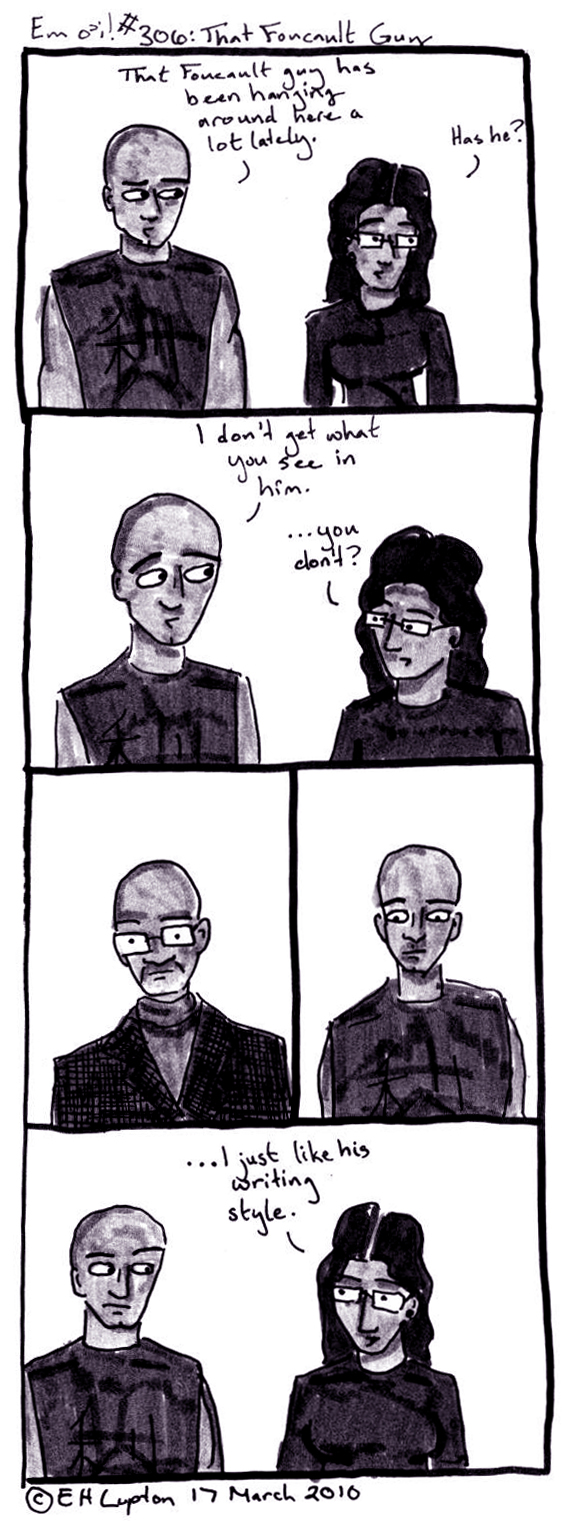
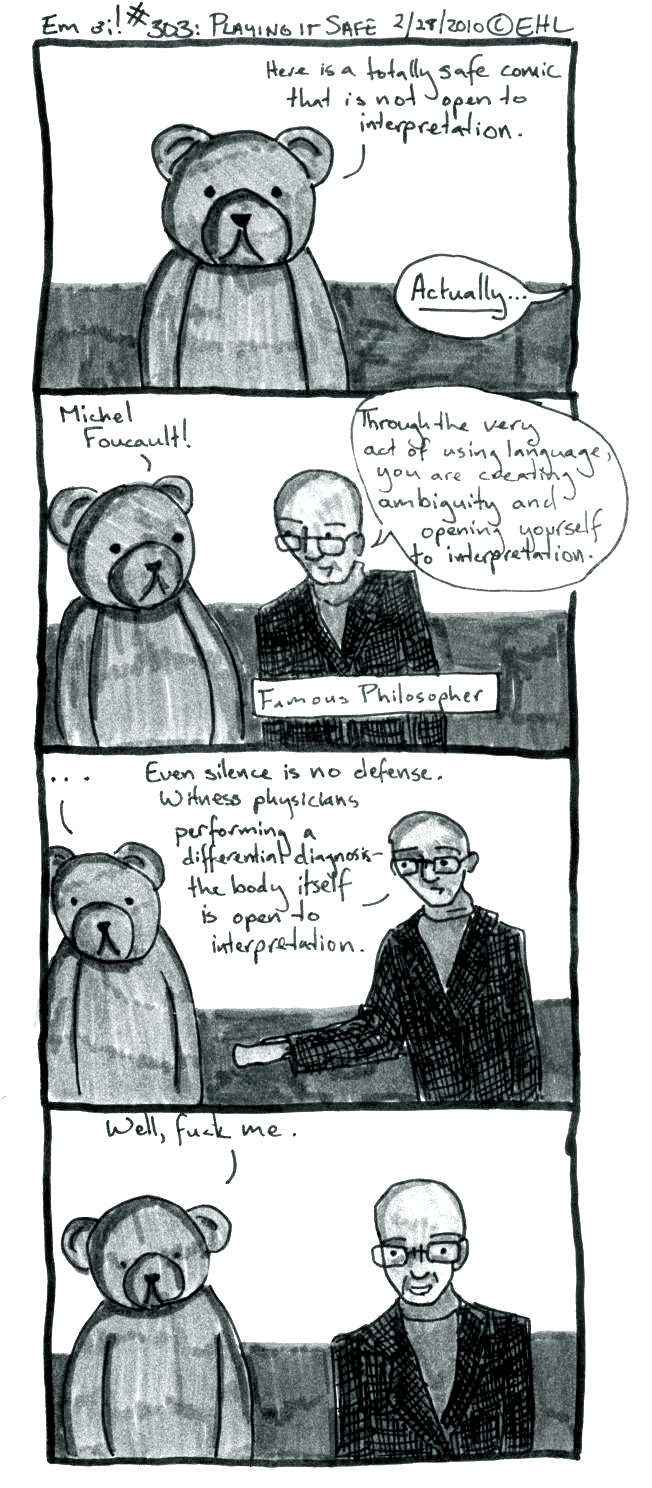

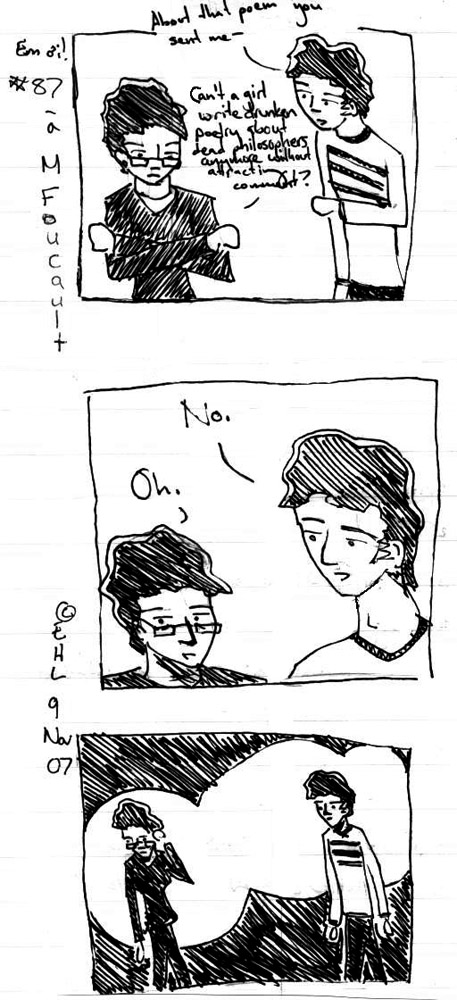
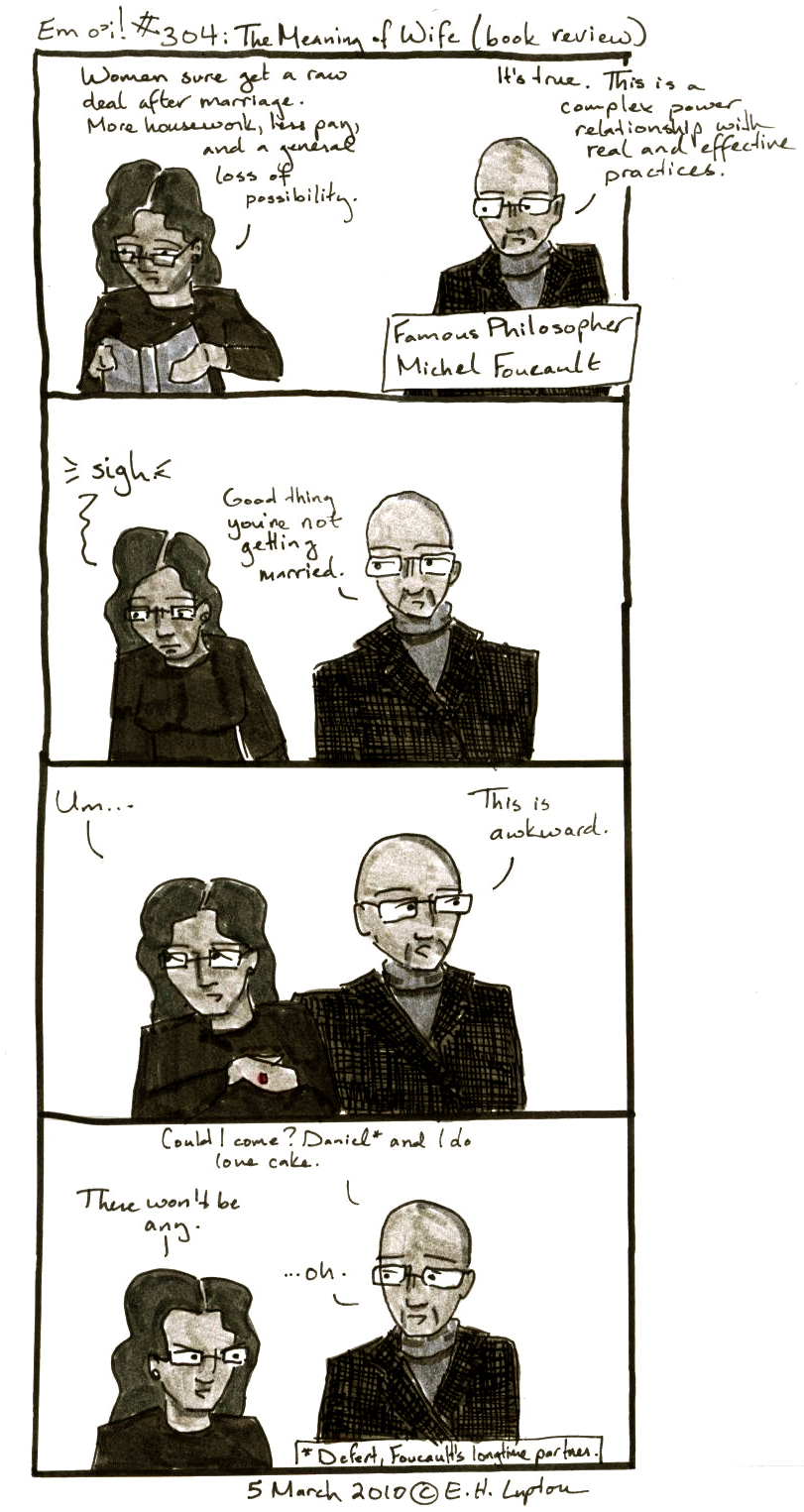
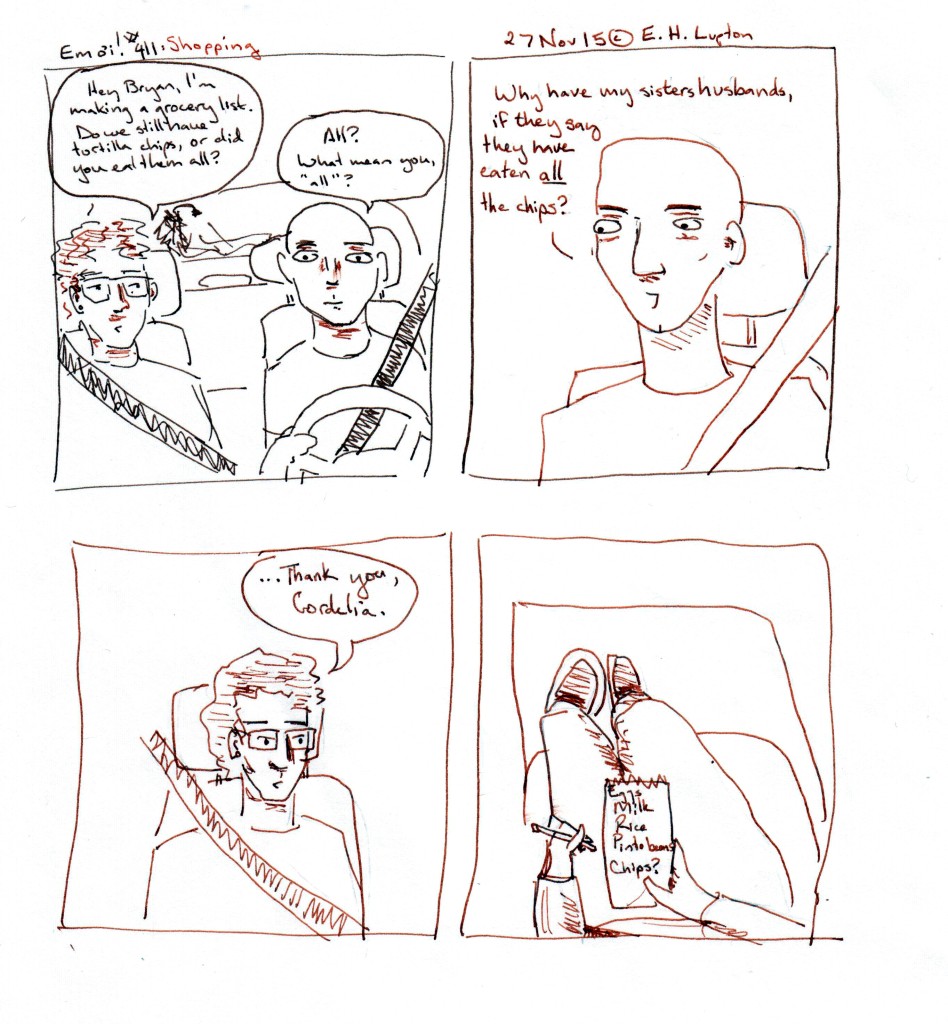
This is the danger of encouraging people to read Shakespeare.
I have an excellent comic for Christmas coming up next week. Hopefully this offering, which I drew mostly freehand at a restaurant, will tide you over until then.
I was going to add a few notes about the Berbee Derby 5K, because it was a fun race, but I’m a bit late, so I’ll give the TL;DR version:
Did a 5.5 mile warm up because I was going to run with some slower friends; when we got to the race, they encouraged me to run at my own pace and then double back and meet them. Bryan had guessed I could finish in under 24 minutes, and I wound up doing it in 24:23, so I was pretty close. I finished just ahead of a fellow from my running group who is a 3:20 marathoner, and was initially elated to have beat him. Then I found out he’d actually just finished a 39-minute 10K and I felt less stoked. Doubled back and did the last half mile or so with my friends. Then home for nap before Thanksgiving.
Was that really TL;DR? Maybe a bit long. Lemme try again:
Ran a 24:23 5K after an absurdly long warm up and also while wearing my heavy sneakers.
Ah, there is proper conciseness. Concision? Something.
Let’s file this under PR2819 A3A L86 2015, for English literature–English renaissance (1500-1640)–The drama–Individual authors–Shakespeare, William–Separate works–King Lear–Texts–Selections. By editor.
Amongst authors, Shakespeare is kind of weird in LCC in that he has all the numbers PR2750-3112 devoted to him, while most authors are subarranged under one number by last name. So for example, the poet Claire Wahmanholm‘s number would probably be PS3624.A3[plus some other digits to put it in order with other stuff in the collection]; the author E. H. Lupton’s work might be filed under PS3612.U8[etc.]. (In a while, you’ll be able to see the actual call number here.) And you can see how those two numbers are only a few digits apart, because ALL post-2001 authors (authors’ surnames) beginning with L are fiiled under PS3612.A-Z, and all those beginning with W are filed under PS3624.A-Z. So I may have inadvertently messed up the number above slightly, because I don’t know if I have access to the correct sub-tables. But close enough is probably okay in this situation.
Click to embiggen. I had already written this script before the attack on Paris last Friday, so I decided to just go with it.
I actually have been reading Being and Nothingness[1], and contrary to my expectations (and it’s reputation, I guess), it’s not a depressing book. At least in the part I’ve read so far, Sartre is mostly concerned with setting out his view of ontology, refuting most of the philosophers who preceded him (everyone from Descartes to Kant, anyway). I’ve done this drawing illustrating the history of philosophy to show you what I mean:
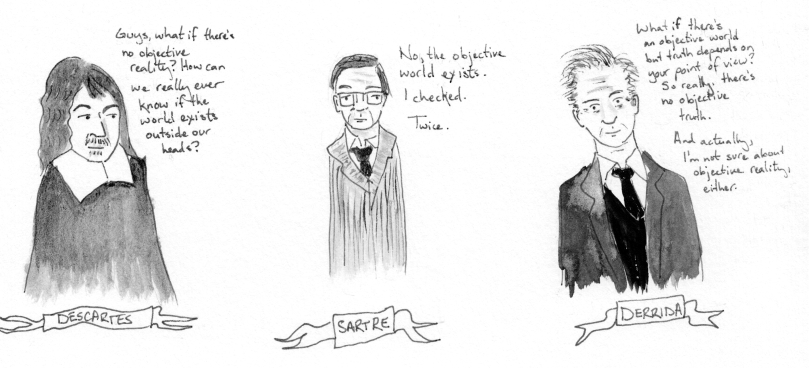
I hope that clarifies things.
What I really love is the feeling that all the stuff I was dragged through as an undergrad–Descartes, Locke, Berkeley, Spinoza, Kant, probably a few others I’m leaving out–seems to be summarized quite elegantly here and then rejected in favor of a philosophy that seems to better describe my intuitions about how my mind/reality work than, you know, Berkeley or anything. I am surprised courses on existentialism were not offered at my university. Or perhaps they were and I didn’t take any–in those days, my focus was more on epistemology (somewhat) and logic, so I read Frege, Russell, and Wittgenstein, among others. The Tractatus Logico-Philosophicus remains one of my favorite books I read during this period.[2] And of course, this was the time during which I discovered Foucault, but I came to him (and Derrida) through the English department rather than the philosophy department.
Here are a few other appearances of these philosophers:
Bonus other comic with Camus:
We can file this comic under B2430.S34L86 2015, for Philosophy (General)–Modern (1450/1600-)–By region or country–France–By period–20th century–Individual philosophers, A-Z–Sartre, Jean-Paul, 1905-1980–Biography, autobiography, criticism, etc.–General works.
In other announcements, if you’re out and about, please consider buying a copy of The Joy of Fishes at A Room of One’s Own (not signed, but we can arrange it) or Mystery to Me (pre-signed). They have been very nice to take a few copies on consignment, so perhaps we can help them move them–you’d be helping not just an indie author, but a local indie bookstore as well. Huzzah.
[1] It’s not really a dreadmill book, so I’ve been reading Neal Stephenson’s Baroque Cycle on the elliptical. I’m currently on book three. Each book is about 800 pages, and unfortunately they often seem to take about the first 100 to 150 to really get rolling. But if you’ve ever been interested in the enlightenment, it’s worth it. I don’t actually think he’s mis-characterizing enlightenment ideals or anything, for the most part. Maybe I’ll talk more about that when I do a review (in a million years when I actually finish it).
[1] I also did a lot of ancient philosophers, especially Plato. Modern philosophers included Philippa Foot, Robert Nozick, and Peter Singer.
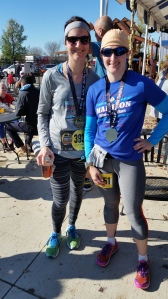
To preface this story, let me say that two weeks ago I did a local Middleton race called the Haunted Hustle. It wasn’t an “A” race, and though it was fun there didn’t seem to be much point in writing it up other than my friend/running companion, Kristi, getting to see her name in “print” here. Since it’s marginally relevant, I’ll just give the tl;dr version here: Hilly course, cool day, lots of costumes to look at, ran a 1:55:55.
That was, at the time, my fastest half of the season, although to be fair my other half was a trail race, and I also did a 20K in 1:50:xx, which is only about 4 seconds/mile slower. Anyway, since I’d signed up for the Tyranena race only two weeks later, my plan was to use the Haunted Hustle as a hard training run and then really race Tyranena hard, with the goal of running a faster time.
The races were only two weeks apart, so my training was unremarkable. The HH was on a Sunday; I ran 54.19 miles over the next week (October 26 to November 1), with one day off for swimming. That week included one day of dreadmill intervals and a 15-mile long run in the rain. The following week, November 2–7, I lifted legs on Monday, then hobbled through 8-milers Tuesday through Thursday and was completely off except aikido on Friday, for a total of 24.4 miles before the race. No taper, that’s me.

Tyranena starts quite late—11:30. I got up early (well, okay, I got up at 7:30) to eat my pop tart, drink a small cup of coffee, and loiter around working on my novel until it was time to go pick up Kristi. Last year we hit real traffic on the beltline and it was very tense, so this year I actually left a bit early. And of course the beltline was empty. We arrived in Lake Mills, WI, about 40 minutes away, by 10:20 and picked up our packets, then stood around chatting for the next 40 minutes or so. At 11, I went out for a warm-up jog, just a mile out at a relaxed pace and then some telephone pole intervals on the way back. I got back with just enough time to find everyone, then jump in the line for the port-o-potties and lose them again. Oh well.
We took off at 11:30 and I fell pretty quickly into an 8:30 min/mi pace. Running with the crowd to break the wind, this definitely felt like a comfortable speed, and I decided to hold onto it as long as I could. A bit before the first mile marker, I bumped into Kristi again, but when she took off (aiming for a sub-1:50 race), I made the decision to let her go and try to stay with what I had. This proved to be a pretty good decision.
The hills on this course are all on the first half, with the biggest coming right around mile four. However, none of the hills is really too difficult; my Garmin clocked 248 ft of elevation gain, compared to 362 ft at the HH. Watching my watch on the uphills, my pace occasionally dipped as far as 8:45 or even 9:00 min/mi, but I always recovered on the downhill. At around mile 5.5, I took a gel, another big change from the HH when I didn’t have anything for the duration. I hit the 10k mark in 54:28, according to the chip, and the halfway point about two minutes later. Up through mile 8, everything went really well. Then I noticed the people I’d been pacing off were gradually moving away from me; I didn’t feel like I was slowing, but my watch was suddenly reading 9:00 for pace.
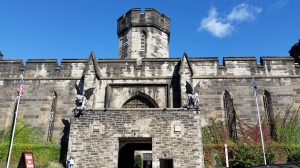
At this point, I made a very conscious decision to push the pace, to leave everything I could behind and do my best to finish in under 1:50. I ran a few intervals using the trees along the path as markers, and gradually brought my pace back toward 8:30. Mile 8 seemed to last forever, but as I hit mile 9 at 1:17:xx, I did some mental math and realized that with 5K left to go, if I could just maintain my current pace I would finish under 1:50 comfortably.
Then, a few minutes later, I remembered that 9+3 is 12 and 9+4 is 13. So if I could run the next 4 miles at 8 minutes/mile, I would be done in 32 minutes. But what are the chances of that happening? Pretty much 0%. But if I ran strategically, it might be pretty close, so I decided to keep on it.
By mile 10, I was definitely beginning to feel the effects of a sustained 8:30 pace, especially in my right hip flexor. Every mile felt like I was making a bet with myself that I could sustain the pace I was running. If I had been smart, I would have brought another gel for this point in the race, but I didn’t really expect I would be doing as well as I was. Also, I didn’t have any other gels at home that morning. Tant pis.
I had a feeling that if I could hit a little better than an 8:30 pace for the actual last 5K, I would hit a sub-1:50. It was at this point that I fell back in with the group I’d been running with earlier and exchanged a few words with them, so I wasn’t looking at my watch and assumed later I just hadn’t been hitting the pace. But looking at my watch splits, I had this:
| Mile | Pace |
|---|---|
| 10 | 8:15 |
| 11 | 8:06 |
| 12 | 8:27 |
| 13 | 7:57 |
| .1 (.26 on my watch) | 7:30 |
I ran a 1:51:40 officially, which is about 100 seconds over a 1:49:59—meaning that even if I’d managed 8-minute miles for 10 to 12, I still wouldn’t have made it.
Last year, I ran a 1:53:13 on the same course, so I improved by about a minute and a half. I also managed my goal of beating my HH time. Part of this involved running strategically rather than stupidly, which is what I usually do. The biggest change was to find a pack or at least a tall guy to draft behind when running into the wind. Normally the decrease in perceived exertion in this position makes me speed up and puts me back in the wind; by biding my time, I was able to conserve some energy I really needed. I also didn’t take off with Kristi, which allowed me to save energy I would have spent very early trying to keep up with her (she’s fast). I took a gel at a good moment, about 5.5 miles into the race, with 7.5 miles on my legs. And I reengaged with my race mentally when I started to slow down and actually pushed myself. So I’ll call that a success, even if I didn’t hit my time goal.
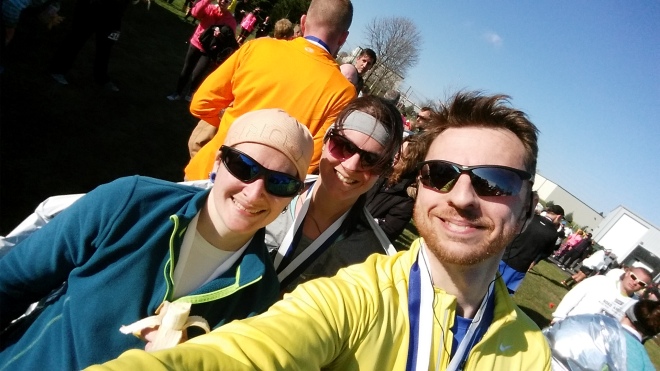
I actually cannot tell if I named this comic “Impatient” or “Inpatient.” Both seem appropriate.
As you can see, I wrote this in early October, just a week or so after Bryan’s operation–this actually did sort of happen during the operation. But I got it uploaded only now because life kind of got away from me last month, a month during which I took care of Bryan, did one marathon and one half marathon, worked on my novel, and changed jobs, or rather job responsibilities, and went from working a kind of weird schedule that could vary from zero to eight hours or more per day depending on what work was available and needed doing to a more typical full-time work week.
Anyway, I’m hopeful that things will calm down a little more in November. Bryan is a lot more mobile and in less pain, my running schedule is calming down so I am less wiped out, and I am maybe getting the hang of some of my new responsibilities, so I am not lying in bed worrying that I will be retroactively fired or something most nights. I have a couple of scripts written that I am itching to get drawn. However, in order to get this stuff done, I may be a bit light on the various social media you typically see me on, so if you need me, drop me an email. (Note to relatives: Email means email, not voicemail. It is not impersonal to send an email. It is helpful.)
No other real news to report, other than since I last posted my novella came out in paperback and you should totally buy a copy. It i s currently held in the Yale library and in the Madison Public Library system and will shortly be available at several local bookstores such as A Room of One’s Own as soon as I can get my act together and drive them down there. Yiss. If you buy a copy and want it signed, or want a signed postcard, see the book tab above and follow the directions to send me an email.
I have a race report for the last two half marathons (I did one this past weekend as well), which I will try to upload tomorrow or Wednesday.
Let’s file this under P301 .L86 2015, for Philology. Linguistics–Language. Linguistic theory. Comparative grammar–Style. Composition. Rhetoric. Usage–General works.
This marathon, you guys. I don’t know what to say about it. It has been a tough couple of weeks for me. And so . . . this is my blog, let’s talk about it.
My training for this race was pretty consistent. I logged 208 miles in June, 221.5 miles in July, 253.8 miles in August, and 229.4 miles in September. My longest run was 23.5 miles, which was our running group’s trek out along the planet path from the Monona Terrace to Mount Horeb. That run happened August 29, and it was basically my last long run of the training session. I had an 18-mile run toward the beginning of August too, and a bunch of runs in the 15–16 mile range. There were some weekends where I meant to do 15/15 or 13/13 across Saturday/Sunday, and typically the second day’s run was not as long as planned. But then again, there were a lot of weeks where I took a random day off on a Tuesday or Wednesday to deal with aches and pains preemptively and then ran on Friday, so my legs typically weren’t as fresh going into the weekend as they might have been.
I also did some speedwork for this race. I did mostly 800s (working up to 10 x 800), 400s, or in the last two weeks, strides (15-second sprints with about 45–60 seconds of recovery). These were always as part of a run with warmup and cooldown on normal terrain, not on a track. My pace on these was usually around 8:00 min/mile plus or minus; in fact, the goal for each run was to do the intervals (not the strides) at 85% to 90% of max HR. I made this decision based on the strategies suggested by Pete Pfitzinger and Scott Douglas in Road Racing for Serious Runners. The book is more geared toward races up to the half marathon distance, but I do so little speedwork that it seemed like a good (and unintimidating) starting point. Eighty-five percent of max HR or 8:00 min/mi works out to be about a 5K race pace, which is slow enough that I’m not (or don’t seem to be) in danger of injuring myself doing it.
Finally, my running group was doing our long runs at close to race pace, often in the 8:50–9:20 min/mi range, which basically turned my long run into a long tempo run every week. This was quite helpful; I started out this training cycle just after the 50K feeling like a 9:20 was very fast, and finished able to do a half marathon distance run at an 8:48 min/mi pace, which required some pushing but felt generally comfortable. As a result, I decided my goal for the race—contingent on having a good taper—was going to be 3:55:xx.
So on the 26th of September, I tested for 4th kyu in aikido. The last weeks prior to the test were for me filled with a lot of aikido classes, so I was feeling a bit bruised by the end of it and ready to taper. Then, on the 28th, Bryan had knee surgery.
Back in the spring, B had his knee scoped. I think the technical term is a knee arthroscopy. The idea was to get a good look at a small defect on the femoral articular cartilage that has prevented him from running for, at that point, a bit over a year. At the time, the ortho shaved down the edges of the defect, and B decided to see how it went. But after rehabbing it, he found that while he could do short sprints during a game of ultimate, he couldn’t really run farther than about a mile and a half with me (on grass-covered trails, specifically) without pain. And then a day came when he went to frisbee and ran too much and the pain didn’t stop for over a week. So he got put on the list for a cartilage transplant.
The thing about being on the list, besides the awesomeness of medical technology that this is an option and the creepiness of having someone else’s cells in your body, is that you don’t know when exactly they’re going to call and tell you it’s time to rock and roll. So B got the call two weeks before my marathon, and possibly because of the aikido test (plus a play we were going to that weekend), he scheduled the surgery they told him Monday the 28th was go day. I’m glad he was able to come to my test, which meant a lot to me, and able to enjoy the play, which would have been difficult if he’d had to try to manage APT on crutches. But it did leave us a rather slender window for him to recover enough for a four-hour car ride.
After the first surgery last spring, he was back on his feet almost right away. Not an exaggeration: We went out to dinner that evening, and I had to glare at him to get him to bring the crutches into the restaurant. The surgery itself was very non-invasive, and they encouraged him to get back to walking as soon as he could. The second surgery ended with a four or five inch incision down the front of his knee, and he’s now on crutches with orders not to put any weight on the affected limb for the first three weeks, with another three weeks of gradual buildup to follow. So not only was his mobility a good bit different, his pain levels were as well; after the first operation, I think he took a few Tylenol, whereas after the nerve block for this one wore off, he needed serious painkillers. And then he developed some other side effects that I’m not going to get into, but suffice it to say that it was kind of an unpleasant week for him.
The thing about the running industry, such as it is and such as I interact with it, is that it is always telling people they have to make running a priority. Going out for a jog, being fit—if you want those things, you have to prioritize them. But the thing is, running is not really a priority for me in that sense. Running is a thing I do in order to stay sane and manage my stress levels, just like brushing my teeth is a thing I do because I have a horrible fear of my teeth falling out like in Tommyknockers to maintain dental hygiene. Race preparation, on the other hand, is something I have to prioritize or it doesn’t really happen.
Over the course of the week, watching B’s health/comfort levels wax and wane, it became clear to me that there was a serious question about whether or not he was going to be able to make the drive up. And I wasn’t ready to leave him to anyone else’s machinations; either we went together or I wasn’t going.[1] So it may be obvious here what I’m pointing at—my taper did not really happen, or not very well.
Monday was also when the race organizers sent out an email informing us runners that a protest by the group Black Lives Matter was being planned to disrupt the race at mile 25. Apparently they (BLM) had first announced their plans on the 26th or so, but I wasn’t following the issue then.
At first, I was quite disappointed. After a really long, stressful summer, I had been really looking forward to going up to see my brother and his wife, hanging out, doing the race . . . it sort of belatedly dawned on me that this was a very privileged way to look at things—they’re ruining my relaxing vacation, my race, and so on, when what they’re asking for—justice for police brutality—is both an extremely reasonable thing to request and something that it’s unlikely I’ll ever have to deal with. Which is to say, anyone in the BLM crowd would also like a relaxing vacation weekend, but they weren’t going to get it.
By, I guess, late Wednesday, I was reconciled to the fact that I would run twenty-five miles to where the protest was, symbolically turn off the course, and then jog back to my brother’s house about a block away. And then do, you know, another 1.2 miles on my own. But I wouldn’t be officially finishing. (I came to this decision in part because of discussions with a number of very smart friends and in part because I read some of the comments on the marathon’s Facebook page and realized which side of the issue I thought I wanted to be on. But also, to be honest, the whole thing also felt kind of secondary to the rest of the stuff that was going on in my life, like something I was watching from a distance.)
Thursday, the city of St. Paul and the marathon people announced that a deal had been struck and the race would not be obstructed. Instead, the protesters would be given 1) a meeting with the mayor, and 2) a place near the finish to hold their protest.
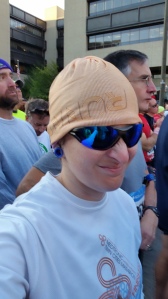
So, spoiler alert, B was able to make the drive up. Friday afternoon and all of Saturday were spent in Daniel and Claire’s most entertaining company, doing things like drinking Pimm’s and grapefruit soda, eating curry, and watching episodes of Sherlock. Then, Sunday morning, we got up early for the race.
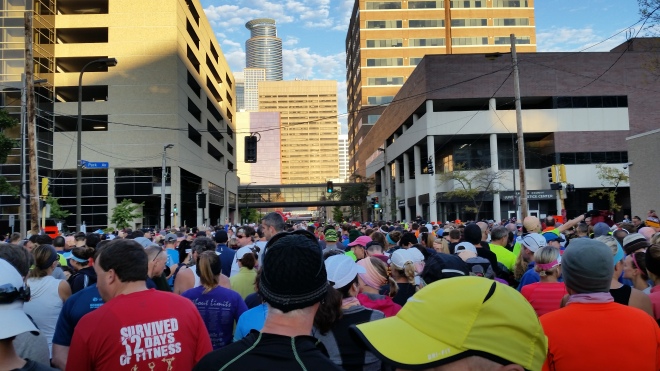
Well, the race was at 8:00; I got up at 5:00 because B got up at 5 to take some pain meds. So it goes. Daniel and Claire kindly dropped me off at a few blocks from the starting line around 7:40, just enough time for a quick warm up and a stop at the port-o-potty. Actually, the PoP I found was right where a bunch of the pros were lining up, so I got to pee within ten feet of the person who actually won the marathon.[2]
The beginning of the marathon was a bit of a problem. The race typically hosts about 8,500 people or so, and we were divided up into four corrals. However, as I jogged along the sidewalk, I could see pacer signs but no indication of where each corral started. I also noticed that the numbers of the runners in the corral I was passing (corral 1) were a different color than mine, which made me anxious that I’d accidentally stumbled into the 10-miler starting area instead.[3] Eventually I ducked in and a woman in a bright yellow vest told me to move back to the 2nd corral (where I was assigned to start).
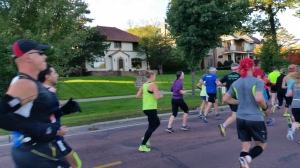
I had jogged about 0.27 miles at this point. For some reason, I decided to just hit lap on my watch rather than clearing it. This had a few unintended consequences. First, during the first mile plus, there were a lot of tall buildings that messed up the distance tracking of my watch; since the time was also off, I couldn’t rely on that to estimate my pace. Second, I didn’t realize that the corrals were going to be released as waves, with several minutes between each. So not only was my watch off from the time on the mile marker clocks by an unknown amount, our wave time was also. Basically, I was pretty lost.
The route starts out downhill for the first mile, then turns up as you run past the Walker art museum (a beautiful building; I’d love to see the collection there sometime) at mile 2. The best sign spotted during this section said “Keep running! . . . Unless you’re Donald Trump!” Then it’s on to circle three lakes, Lake of the Isles, Lake Calhoun, and Lake Harriet from around the 5K mark. This part of the race is great—the houses ringing each lake are easily some of the priciest properties in the city, and there was a good crowd out to watch and cheer us on, too (and all of their dogs).[4] I felt very strong and relaxed through this section, and I was making pretty good time, clocking low 9s and even some high 8s (8:58, 8:46, 8:48). I came through the 5K in 28:xx and the 10K in 56:xx. Around mile 8, we left the first three lakes and entered a long, fairly flat part that went beneath some underpasses and eventually left us near Lake Nokomis around mile 11. I had originally thought I was going to see Daniel and Claire during this part of the race, so I stayed occupied looking for them in the crowds. Later I found out that they missed me in several places by only a few minutes. Crumbs.

I came through the half marathon point in what I thought, after considerable mental calculation, was about 1:58:xx. I was still moving well, and I knew if I could do the second half in that amount of time, I would wind up very close to my goal. At this point, I decided that I was going to take it easy until I reached Summit Avenue, and then really hammer it home on the last 10K. Just really leave it out on the course.
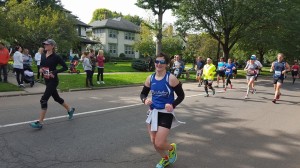
Of course, there were some complications. Aren’t there always? Somewhere around mile 17, my left knee began to ache. At first I thought it might be my IT band, since jogging with Daniel the day before he’d mentioned his own ITB issues. I slowed considerably because of the pain, and the four hour pace group was suddenly right behind me. I managed to gap them briefly, only to be caught when I stopped to stretch. I told myself I’d catch them back up, but I didn’t see them again for the rest of the race. Of course, the problem wasn’t my ITB—it was my hip.[5] So there wasn’t really anything I could do. I tried to just relax and enjoy the day, since I quickly came to the realization that my goal time was not going to be met. At one point, I saw a lady with an orange tabby cat on a leash. The cat was lying in the grass, looking pretty chilled out, all things considered. I shouted at her, “That’s a funny-looking dog.” She seemed confused and shouted back, “Thanks?”
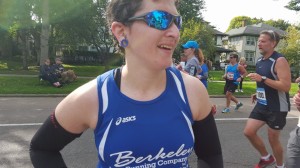
Around mile 19, there was a considerable hill near the University of St. Thomas that I’d forgotten about. At the top of it, a friend from my running group, Julie, was spectating, and she jogged about a block with me. That gave me a big boost. Then I finally got to turn onto Summit, which was kind of a bummer because the first two or three miles are one gradual hill. I don’t remember noticing it last time, but this time it was both obvious and hard. But I got to see Daniel and Claire in there (I think around mile 22), so that was another exciting boost.
Summit Avenue is another really nice section of town with really expensive old houses to gawk at. As I recall from 2008, the stretch between miles 23 and 24 was the longest ever. Although I kept hitting the lap button on my watch when I passed a mile marker, it was never registering a mile when I got to the next one, so everything seemed interminable. I was also having quite a bit of pain in both knees by this point. Then I got to see not just Daniel and Claire at mile 25, but B as well—he’d managed to crutch down to see me hobble by. What a rush!
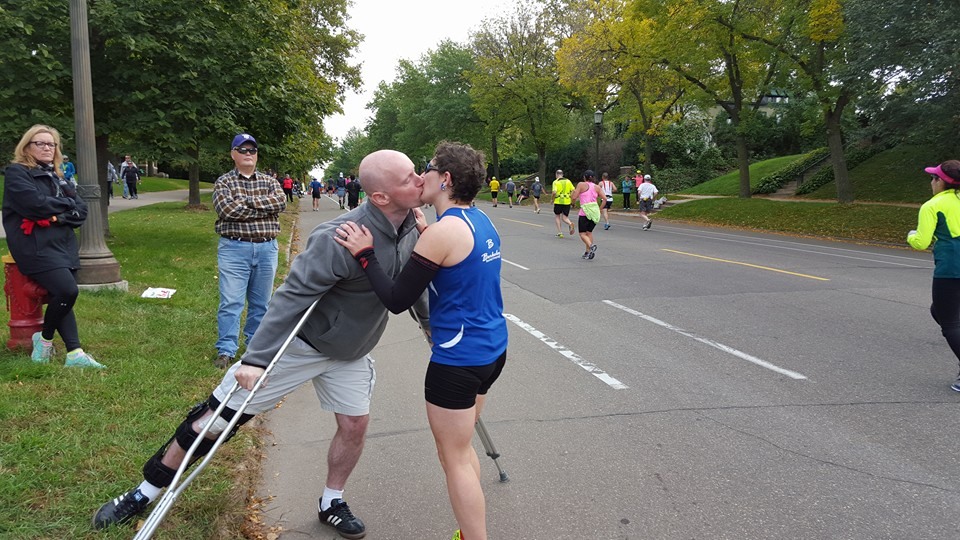
I did reflect, as I left him, that if the protest had gone off as planned, I would be stopping at that point. And, to be honest, I would have been totally okay with stopping. But I was so close.
As I approached the finish line, I remembered the protest again. I had planned to symbolically raise my hands in the “hands up” gesture as I ran past them to express my solidarity for the protesters, since I thought from what I’d heard from the race that it was unlikely they were going to give runners the option to exit the course.[6] But I didn’t actually see the protest. I did see, off to the left behind a chain-link fence, a bunch of people holding signs, but they were mostly white, and also standing in a circle facing inward, so I couldn’t really read any of the signs to determine what group they represented. And I was actually in some not-inconsiderable pain and very focused on just getting through to the finish line, so I decided not to stay and look around and just kept going.
I finished in 4:03:36, about eight minutes off my goal time. The first time I ran the TCM, in 2008, I finished in 4:41:10, so I’ve made considerable improvements in the last seven years. I’m not quite where I want to be/think I should be, but I’m somewhere other than where I started. And that’s sort of the idea, I guess.
As I mentioned, I crossed the finish line with pain in both knees. Fortunately, there was no permanent damage. With B’s help, the joint got shifted back to its proper position, and I am now again pain-free. I have already been out and run a few times this week, with no noticeable problems other than my quads being tired. I also felt pretty beat up generally at the finish; I think I have done so many trail races lately that I had kind of forgotten how running so far on concrete makes you feel like you’ve been beaten. My next two races are on a combination of cement and gravel, so we’ll see how that affects me.
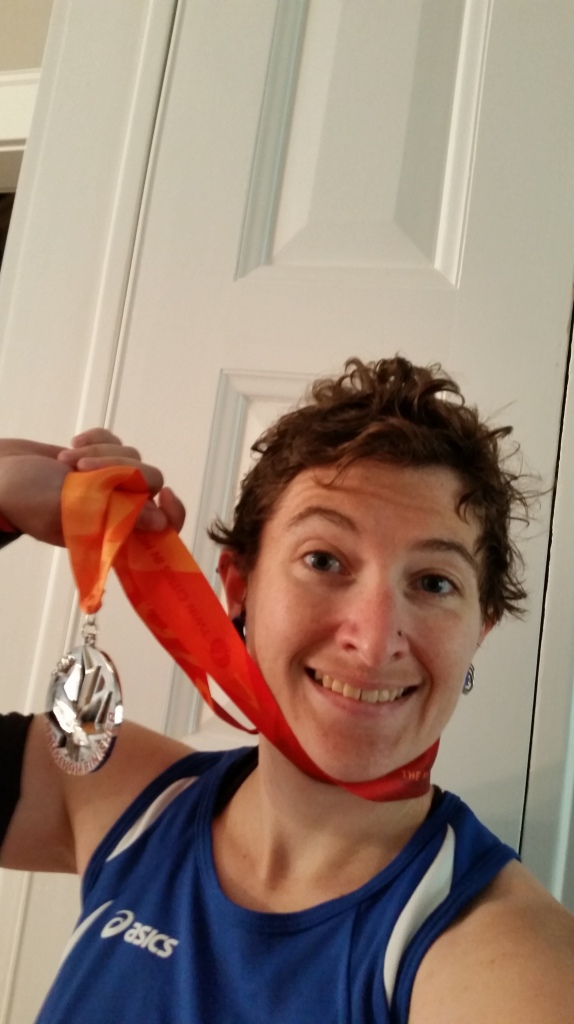
I also finished with some pretty bad chafing on my back—it seems the belt I was carrying my phone in bounced around a lot, to the point where I had several kind of ugly, bloody scrapes on the small of my back. Those are still healing—yesterday at aikido, I noticed the top piece of my hakama occasionally digging into them when I fell. Ow.
Other than those, life has been pretty decent. And B’s recovery has been going pretty well.
When I told the story of this race to a friend, she asked why I didn’t just stop when things started to hurt. I don’t really have a good answer. I guess I just didn’t feel like anything was bad enough to warrant stopping, so I didn’t. What kind of what would warrant stopping? I don’t know the answer to that either. I do know that I have one more big race (ultra) and a half scheduled for this year, and possibly a 5K or 10K on Thanksgiving, and then I’m going to take it a little easy for a while. Easy meaning nothing longer than a half, maybe doing some weird trail race distances that are, you know, 15K or whatever. Maybe doing some more swimming. I feel like I say that a lot after marathons. I guess time will tell if I actually mean it.
[1] Not to sound too noble. I was going to run 26.2 miles on Sunday regardless of where I was, but if I was at home, I was planning to do 5 x 5 mile loops with a break for an ice cream sandwich after each.
[2] Okay, that was one of the weirder sentences I’ve written.
[3] I found out later that the 10-mile race had already been won by the time we set out. The winner finished in about 56:xx. Holy cow.
[4] Best dog: a husky who, when he heard the crowd shout “Woo!,” started howling. Also spotted a small bear-like beasty (possibly a chow puppy) being held and bounced like a baby by its owner.
[5] My SI joint slips, and then one of my legs becomes longer than the other, putting pressure on my knees. I’ve started doing more plank/dead bugs/half bridges to try to prevent it, but it still happens.
[6] So for liability reasons, races don’t want you leaving the course without telling anyone. There have been cases of runners getting eaten by bears and so forth—of course, an unlikely outcome in a big city marathon, but still.
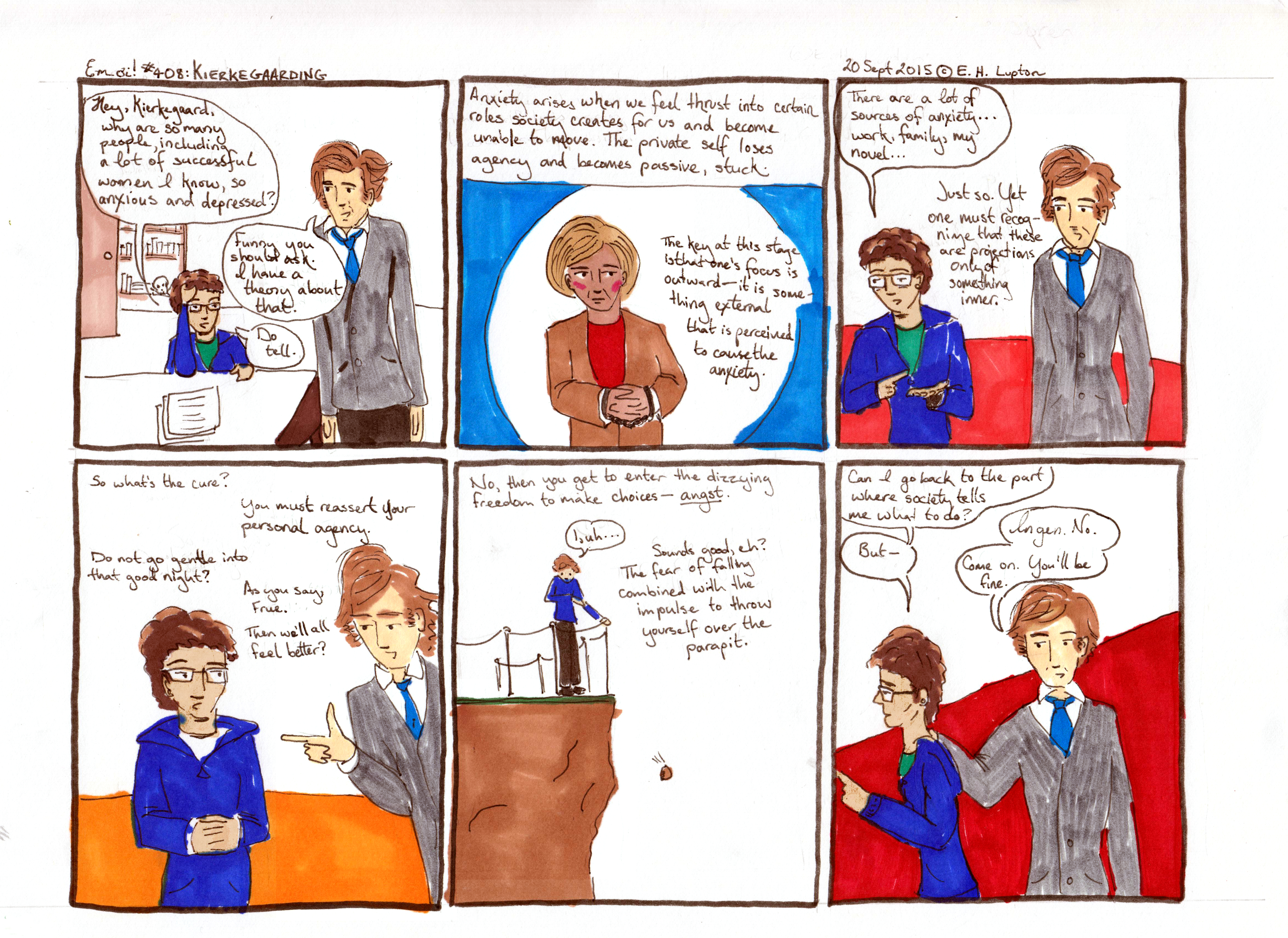
I am forced to begin this week’s lengthy and possibly unreadable commentary on the comic with an apology: I am somewhat misconstruing Kierkegaard here.
Here’s the deal: Kierkegaard wrote a book called The Concept of Anxiety, which is the basis for the ideas that form the underlying framework here, but in the book, Kierkegaard is actually not talking about how difficult your problems are. Instead, he was talking about the responses of different religions to the idea of original sin.[1] That is, he seems to be making an argument like this: 1) Original sin happened, but there were/are people who don’t know about it because they’re not Christian (pagans) or they’re Jewish (??). 2) These groups experience anxiety in different forms (turning outward, in the case of the pagans; turning inward, in the case of the Jews, which is more correct but still unable to come to any resolution, which can only be reached by Christians because Jesus. 3) The angst as freedom of choice is still in there.
If all this sounds a little weird, well–Kierkegaard was kind of a strange guy and his philosophy is a little bit aphoristic. And this is one of his most difficult books.
These anxiety-to-outside/inside relations were distilled by another fellow, Stephen Dunning[2], into the framework that underlies the first three panels (anxiety-in-itself, anxiety-for-itself, and anxiety-in-and-for-itself), and then further distilled by another writer (whose book I cannot name yet, since it hasn’t been published) into yet another form that I’ve adapted here.
In other words, this is based on some secondary materials that somewhat (in my mind) misconstrued the original argument. Le sigh.
Also, I hadn’t used these markers with this type of paper before, and I am disappointed by how it absorbed them. It doesn’t look really as nice in person; I had to do a lot of fixing, some of which is sadly visible. Tch.
I’m currently trying to taper for the Twin Cities Marathon, which is coming up in just over a week. But B is having knee surgery on Monday, so we’ll see how well that goes. My training has been pretty average, but consistent, including consistent speed work, and my ankles are holding up really well (knock on whatever), so I’m guardedly optimistic. If I can get a good taper and decent weather, I hope to hit sub-4. I’ve been running sub-2 hour half marathons in practice, so I have a feeling I can do it. If I don’t get a good taper, I’ll see what I can do. The goal is 3:55:xx, which requires an average somewhere between 8:50 and 9:00 minutes/mile (okay, 8:58 to be precise); of course, the fact that I can sustain that for 13.1 miles is rather meaningless when we’re looking at twice that distance.
Until then, I’m sort of swamped with work, but I will still try to have a new comic up next week as well.
For the nonce, let’s file this one under B4377 L86 2015, for (deep breath) Philosophy(General)–Modern (1450/1600-)–By region or country–Scandinavia–Denmark–By period–19th century–Individual philosophers–Kierkegaard, Søren, 1813-1855–Criticism and interpretation.
[1] Side note: He says, among other things, “Jewish anxiety is over the possibility of guilt, rather than ‘the positing of an actual [guilty] relation'” (Dunning, 153). This is clearly false; Jewish anxiety is over many things, but most of them involve the possibility of disappointing your mother and whether or not this tickle in the back of your throat is going to turn into pneumonia or not.
[2] See Stephen Northrup Dunning. Kierkegaard’s Dialectic of Inwardness: A Structural Analysis of the Theory of Stages. Princeton, NJ: Princeton University Press, 1985. Retrieved from Google Books: Link